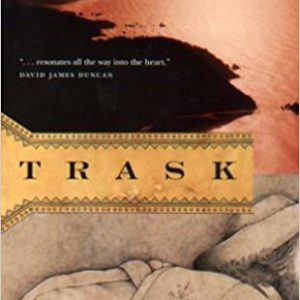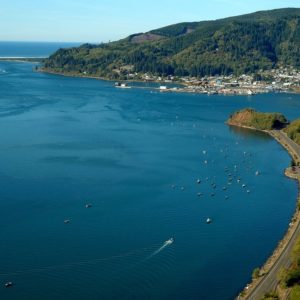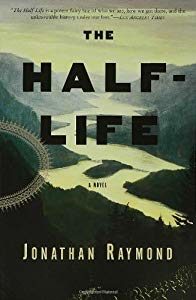Westerns in 2018
 I just recently finished two Westerns by Oregon authors that are outstanding.
I just recently finished two Westerns by Oregon authors that are outstanding.
Preamble: On the north and central Oregon coast many geographical names have native origins and there is a similar sound to them, Nehalem, Neahkahnie, Nestucca. Then oddly around the town of Tillamook there is a river named Trask, which doesn’t roll off the tongue like any other place name in that region. A couple summers ago I called out the clunky name to Andy as we drove over the Trask to get to Bayocean spit. But I didn’t think of it again until I saw the book Trask sitting on a shelf at Powells this summer.
Trask was written by Don Berry, a graduate of Reed College and whose cohort included beat poets and a beloved professor, Lloyd Reynolds, who is revered in local Portland lore.
Trask was Berry’s first novel and it was published in 1960 when he was just 28. It is a historical story of real-life trapper/explorer/homesteader Elbridge Trask. And Trask, I discovered, was one of the first white homesteaders on Tillamook Bay.
This book is an action-filled story that was meticulously researched by Berry. And Berry’s detailed work combined with his mad talent and love of Oregon resulted in a book that is considered by critics to be one of the best novels set in Oregon. The other novel cited in the same breath as Trask is Sometimes a Great Notion by Ken Kesey.
The story centers on Trask’s on-foot journey from Fort Clatsop in the early 1840s, near present day Seaside, Oregon, to meet with the Killamook natives. We learn in the first chapters that Trask has grown restless on the settled north coast and wants to see Murderer’s Harbor for himself. (Nowadays Murderer’s Harbor is less threateningly called, Tillamook Bay). And if Trask is lucky and happens to survive the overland journey, he plans to ask the Killamooks for permission to settle there. Trask sets out on this folly with two friendly Clatsop natives as his guides. And not unexpectedly the group endures bad weather, battles rugged landscapes, and gets spooked by occasional sightings of the unknown Killamooks, who are likely tracking their progress through the shadow-laden forest floor.

Originally Lewis and Clark spelled the tribe’s name as Killamuck, but throughout the book Berry writes the name as Killamook, as it was sometimes used in the 19th century. In present time the name of the tribe has been altered to Tillamook.
I was bewitched by this novel and got caught up in the trek to Murderer’s Harbor with Berry’s spot-on descriptions of rain, forests, and the exhausting effort needed to climb wind-whipped headlands.
Read this book when you want an adrenaline charge and your mind’s eye to fill with a dark forested place steeped in spooked-out grey mist. Trask is an honored novel with a well-deserved reputation.
The second Western I read is The Half Life by Jonathan Raymond. It is Raymond’s first novel and was published in 2004. The book is only half of a Western because it is built around two separate narratives set 160 years apart –on the same ground.
The first story line takes place in 1820s Oregon Territory and begins by introducing Cookie Figowitz, a hapless cook working for a trapping party, who finds a naked stranger in the woods. Cookie immediately hides naked man away from the rest of the trappers. It seems the trappers are lost, and they are growing restless and angry over the dwindling food supplies as they wander day after day looking for the trading post. Cookie rightly fears for his and the stranger’s safety.
Over time the two men become fast friends. Henry, the naked man, complements Cookie’s personality. Where Cookie is shy, soft-spoken, and fearful, Henry is bold and has traveled the world, tussled with it, and is -when we first meet him in all his naked glory—hiding from Russian trappers who want to kill him.
Cookie and Henry concoct a plan to set off on a risky venture to China. There Cookie and Henry hope to sell castoreum, a beaver musk the two believe the Chinese marketplace will consume. Cookie and Henry move forward with the plan despite knowing strict Chinese law forbids common sailors from engaging in any type of trade with their citizens. High adventure ensues.
The second narrative begins 160 years later. Teenagers Tina and Trixie wander the same ground in Oregon where Cookie and Henry first met but now that ground is a disorganized tree-hugger commune comprised of cabins in random stages of disrepair and mustiness. Trixie has been banished to the commune after getting in trouble in California and is living with a family friend. Tina’s mother is out of work and plans to get it together while staying at the commune before starting her career again. Tina’s more subdued personality and Trixie’s flamboyant and creative personality meld well, they complement one another. A friendship is born.
As time passes and their friendship deepens, Tina and Trixie create a detailed plan to make a movie. Then, during the surprisingly successful beginnings of their film project, two skeletons are found on the commune’s ground. And once again in this novel, high adventure ensures.
You probably know a little about the author, Jon Raymond. Raymond is one of those guys…he’s deeply talented and productive, so his name pops up frequently. He published a short-story collection Livability after The Half Life. And then he co-wrote two films from the collection, Old Joy and Wendy and Lucy. He also wrote the screenplays for Meeks’s Cutoff and Night Moves. He wrote the HBO miniseries, Mildred Pierce. He is an editor for Plazm magazine (https://plazm.com/ ). He grew up in Portland and lives here still.
If you have had exposure to any of Raymond’s work, you’ll know it is neither bright nor gooey. Raymond is at his best when he creates stories that emerge from breakdowns and extreme change. His stories often contain a juncture where we are likely to lose sight of the story’s most vulnerable characters. And when he brings his readers to witness breaking points and loss, he is able to elicit a powerful empathy in us. Read Half-Life.
